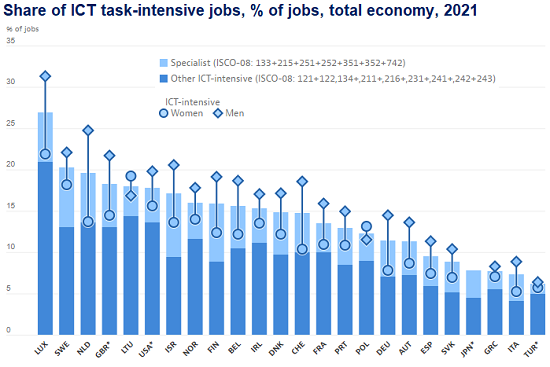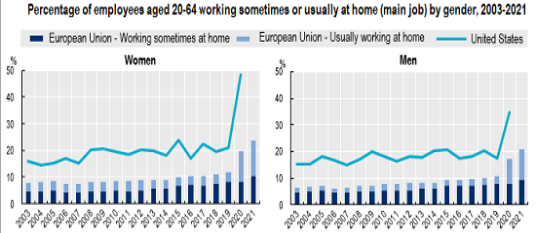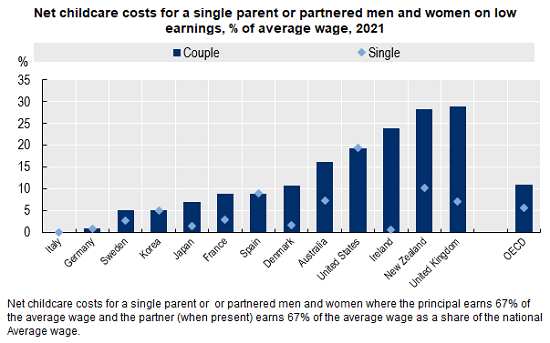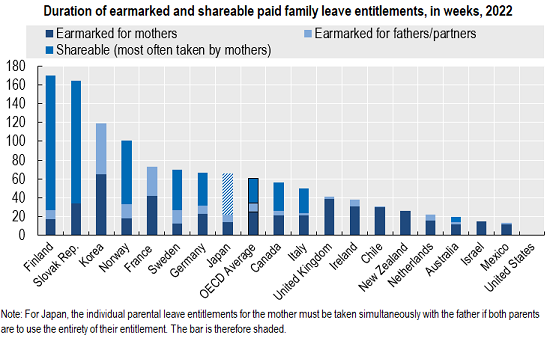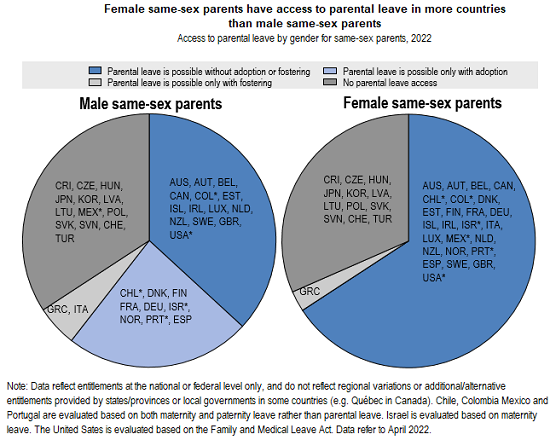Gender-Data Expansion
In 2021, the United States initiated this project to extend the coverage of gender-sensitive data across the OECD and its Member Countries, thereby contributing to tracking progress on gender equality and women’s economic empowerment. The OECD gratefully acknowledges the U.S. State Department's financial support for the project and the development of indicators and the underlying methodology.
|
|
Gender-data are key to closing gender gaps. Across the OECD, gender gaps remain in all spheres of social and economic life. Despite progress, women and girls continue to face barriers and disadvantages at home, on the labour market and in public life. Over the life-course, gender differences result in large gender gaps in economic empowerment and security, life-time earnings, pension income, and risks of old-age poverty. |
|
In 2021, with the ‘Gender-Data Expansion’ project, the United States supported further efforts towards closing gender data gaps in the policy areas of digitalisation, teleworking, taxation and child-related leave, by improving, developing and mainstreaming gender-sensitive indicators, as well as developing a roadmap for strengthening capacities and methodological tools for data collection and use. |
|
|
|
Advancing gender-data collection in the digital sphere: Bridging the digital gender divide The gender divide in the set of skills needed to live and work in a digitalised economy and society hinders women’s ability to search for and apply for jobs, secure a job, and thrive in an existing job, as well as engage and succeed in entrepreneurial activities. Connectivity divides also fundamentally impact the extent to which women can participate in a highly digital economy and society. Expanding the collection and accessibility of gender statistics relevant to the digital transformation is essential to understanding the existence and extent of digital divides across the OECD and developing well-suited policies in response. To develop new indicators and enhance existing gender statistics, it is necessary to use both traditional and non-traditional data collection techniques, foster trust by all actors, and ensure that data quality is maintained and biases are addressed, including those that might emerge with non-traditional data collection approaches, such as using internet-based data and compiling them into statistical indicators, as well as developing interdisciplinary approaches to data collection. Project work in this area involved the preparation of various indicators with a gender breakdown, and upgrading the OECD Going Digital Measurement Roadmap to obtain more gender-data in the digital area. Outputs include: • Indicator on Top-performing 15-16 year old students in science, mathematics and reading with a gender breakdown, in the OECD Going Digital Toolkit. |
|
|
Advancing gender-data collection on teleworking: Teleworking through the gender looking glass COVID-19 has brought teleworking to the fore, a practice that was marginal in OECD countries before the pandemic. As this new arrangement of working life settles in, accurate data to describe this phenomenon and to analyse its effects on labour market indicators, including gender disparities, are key to designing well-informed polices. Data gaps and the use of inconsistent definitions only allow for a partial overview of this phenomenon. Project work in this area involved the analysis of available definitions and data on teleworking and work from home, detailed in the following output: • Working paper “Teleworking through the gender looking glass: facts and gaps” (draft paper available, final version to be published in 2023), presenting a repository of sources on teleworking indicating whether or not they allow for gender disaggregation; proposing ways forward for data collection – including a consistent definition of teleworking; analysing gender-disaggregated data on teleworking use and effects on gender disparities in labour market outcomes; and suggesting a roadmap for future research. |
|
|
Advancing gender-data collection on taxes and benefits: Promoting gender equality in tax systems Taxation and income support policies shape the payoff from paid work, which can affect the decision to enter or re-enter the labor force even before the birth of any children, and once children no longer require childcare services. Promoting gender equality in tax systems requires ensuring that they provide incentives for women to increase their participation in the labour market. Project work in this area involved expanding and using gender-data to understand how countries’ tax policies impact the incomes of part-time workers, who are disproportionately women, and to understand how taxation and income support policies shape the payoff from full-time employment for lone mothers and partnered women. Outputs include: • Working paper on Taxation of part-time work in the OECD (2022) building on the OECD’s Taxing Wages models to create new indicators that highlight the implicit biases in the labour taxation of women. These include: an indicator on Part-time gender income gap, an indicator on Impact of the tax system in reducing gender income inequalities, and an indicator on Marginal effective tax rates for part-time workers moving to full-time work |
|
|
Advancing gender-data collection on paid parental leave: Updating systemic leave data and data on family leave uptake Paid parental leave and childcare policies are key to ensure a more equitable distribution of paid work and family obligations, which would contribute to closing the gender employment gap. Except for the United States, all OECD countries have national statutory rights that entitle mothers to paid maternity leave around childbirth. Paid paternity leave is also common, though usually shorter and provided in fewer countries. Despite widespread availability of family leave options for fathers, and the numerous benefits fathers’ leave taking has for families, their uptake of paternity and parental leave remains low. To encourage fathers to take more family leave and take a more active role in childcare, many countries have recently introduced or expanded fathers’ individual entitlements to paternity and parental leave. The OECD Family Database provides a high level overview of parental leave systems across OECD countries. However, many countries have recently adapted or extended their leave schemes, often by granting fathers longer and/or exclusive entitlements. Moreover, since an increasing number of OECD countries formally recognise same-sex marriages or partnerships, the inclusion of same-sex partners in family leave legislation is slowly improving. Therefore, advancing data collection efforts on leave systems and leave use is needed in order to provide a more granular and precise picture. Project work in this area involved the update of systemic leave data and data on family leave uptake. Outputs include: • Indicator on Key characteristics of parental leave systems extending the coverage of statutory leave entitlements from 2018 to 2022. In addition, this indicator has been improved to provide information that further disaggregates the entitlements to parental leave into weeks exclusively reserved for mothers, earmarked for fathers/partners, and those that are freely shareable between both partners. |
|
Capacity building Closing the gaps in gender data requires having the right institutional setting and administrative capacities in place to collect and elaborate such data. The work on digitalisation, telework and parental leave have allowed to identify a number of areas where further work is needed in terms of data collection and indicators’ development by data collection bodies. In parallel, the expansion of data collection systems needs to be accompanied by adequate training and capacity building for such organisations. Project work in this area involved: • Preparation of a Roadmap for capacity building, identifying key challenges and the way forward for the availability and collection of gender-disaggregated data in the fields of digitalisation, teleworking and parental leave and the potential contribution of gender-disaggregated data to the research agenda. The roadmap also presents a menu of actions for stakeholders to build capacity to collect gender-disaggregated data at the national level. |
|
Related links:
- U.S. Women’s Economic Security
- U.S. Strategy on Global Women’s Economic Security
- U.S. Secretary Blinken's Remarks at the Launch of First U.S. Strategy on Global Women’s Economic Security (4th Jan. 2023)
Related Documents



